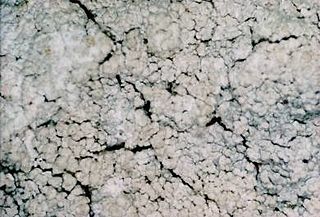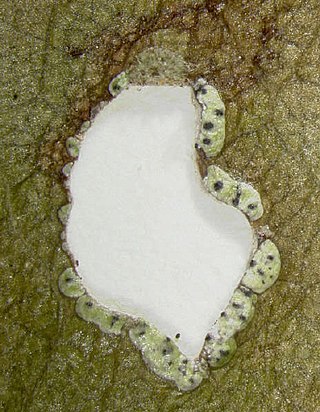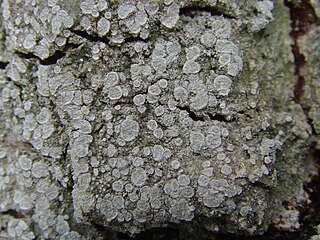
The Graphidaceae are a family of lichens in the order Ostropales.

Ochrolechia is a genus of crustose lichens in the family Ochrolechiaceae.

Ramalina is a genus of greenish fruticose lichens that grow in the form of flattened, strap-like branches. Members of the genus are commonly called strap lichens or cartilage lichens. Apothecia are lecanorine.

Phaeographis is a genus of lichenized fungi in the family Graphidaceae. It has an estimated 180 species.

Acanthothecis is a genus of lichen-forming fungi in the family Graphidaceae. The genus was circumscribed by Frederick Edward Clements in 1909.

Rhizocarpon is a genus of crustose, saxicolous, lecideoid lichens in the family Rhizocarpaceae. The genus is common in arctic-alpine environments, but also occurs throughout temperate, subtropical, and even tropical regions. They are commonly known as map lichens because of the prothallus forming border-like bands between colonies in some species, like the common map lichen.

Lepraria is a genus of leprose crustose lichens that grows on its substrate like patches of granular, caked up, mealy dust grains. Members of the genus are commonly called dust lichens. The main vegetative body (thallus) is made of patches of soredia. There are no known mechanisms for sexual reproduction, yet members of the genus continue to speciate. Some species can form marginal lobes and appear squamulose. Because of the morphological simplicity of the thallus and the absence of sexual structures, the composition of lichen products are important characters to distinguish between similar species in Lepraria.
André Aptroot is a Dutch mycologist and lichenologist.
Alan W. Archer is a mycologist and taxonomist. He is currently an honorary research associate at Royal Botanic Gardens Sydney. He uses chemotaxonomy as well as morphological features in taxonomy and to devise keys, most recently for the genus Pertusaria in the Australasia region.

Catillaria is a genus of crustose lichens in the family Catillariaceae. The genus was circumscribed by Italian lichenologist Abramo Bartolommeo Massalongo in 1852. It is the type genus of Catillariaceae, which was circumscribed by Austrian lichenologist Josef Hafellner in 1984.

Strigula is a genus of lichen-forming fungi in the family Strigulaceae. The genus was circumscribed in 1823 by English mycologist Elias Magnus Fries.
Pertusaria salazinica is a species of crustose lichen in the family Pertusariaceae. Found in Australia, it was described as a new species in 2017 by lichenologists Alan Archer and John Alan Elix. The type specimen was collected in Tully Gorge National Park (Queensland) at an altitude of 885 m (2,904 ft). Here, in a montane rainforest, it was found growing on a rotting log. The specific epithet refers to the presence of salazinic acid, a major secondary compound in the lichen. It also contains norstictic acid as a major metabolite, and connorstictic acid as a minor metabolite. Pertusaria salazinica is only known from the type specimen.

Lepra is a genus of lichen-forming fungi in the family Pertusariaceae. Although the genus was created in 1777, it was not regularly used until it was resurrected in 2016 following molecular phylogenetic analyses. It has more than 80 species, most of which were previously classified in genus Pertusaria.

Robert Lücking is a German lichenologist. He is a leading expert on foliicolous lichens–lichens that live on leaves.

















